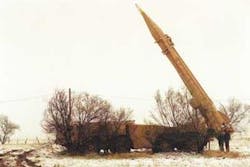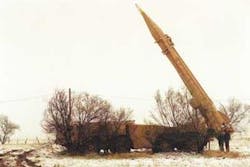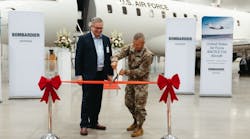By Ben Ames
ROME, N.Y. — When U.S. forces tried to block Iraqi forces from firing Scud missiles last March, they relied largely on knocking them out of the sky with Patriot anti-missile batteries.
Now U.S. Air Force researchers are working on a way to stop the missiles before they ever leave the ground, by predicting the enemy's moves.
The new technology is a software application called A2IPB, for automated assistance with intelligence preparation of the battlespace. Soldiers feed the latest battlefield conditions into the program, and it replies with the enemy's most likely next geographical move.
"For instance, in Iraq we know where the Scuds were garrisoned, and that the Iraqis often operated them under doctrine developed by the Soviet Union," says Chuck Mitchell, group manager for decision support systems at Zel Technology of Hampton, Va.
"Then we look at their range, condition of their roads, strength of their communication networks, and location of friendly targets, and we can calculate where the launcher would have to be to hit us," Mitchell says.
In June the Information Directorate at the Air Force Research Laboratory in Rome, N.Y., awarded a five-year, $24.9 million contract to Zel to do testing, fielding, and user training of the new software.
The idea of predicting the enemy's moves is not new. The U.S. Army originally used a manual version to focus on theater missile defense, such as how to find a Scud TEL (transporter, erector, launcher), Mitchell says. Then the Air Force adopted the IPB process, and made it target-independent, tracking everything from satellites to submarines, and terrorists to cyber-threats.
Zel first launched the A2IPB application five years ago, and soldiers used it in JEFX 2002, the biannual joint expeditionary force experiment. Finally, in April Zel engineers delivered version 3.0 of the software to the Air Force.
"Ours is different [from the Army version] because it's more automated, and it factors in a third dimension — the air," says Col. Allen D. Roby, director of intelligence at the Air Force Command and Control & Intelligence, Surveillance and Reconnaissance Center (AFC2ISRC) at Langley Air Force Base, Va.
"We factor in terrain, weather, and force organization, then match that with templates of enemy doctrine, which dictate how they march their forces in the field in a certain combat situation. So we can predict where they'll go next," Roby says.
A2IPB outputs a "named area of interest," then Air Force researchers can deploy unmanned aerial vehicles (UAVs) or ARGUS (advanced remote ground unattended sensor) systems to precise targets, instead of sweeping over vast areas.
"It lets us more effectively use our ISR (intelligence, surveillance, and reconnaissance)," Roby says. "Today we send the Predator up to look for information, then track any targets we find. But now, we'll be able to send the Predator to exactly where we expect to see something."
Of course, asymmetric threats like irregular militias and terrorists do not follow known doctrines, so the system needs extra help to predict their movements. That is when day-to-day observation and observers on the ground are crucial, he says.
In the future, Air Force planners hope to automate that ground-based data collection, by equipping soldiers with laptops and laser rangefinders on their binoculars, to feed real-time signals into the program. Such tactics are used today only by special forces.
And they plan to automate that data flow, so the sharing happens instantly.
"We need automated exchange of information between machines," says Roby. "It takes too long when we write it down on a yellow sticky note, walk it over to someone who types it into his machine, then radios it to a fighter jet, where the pilot types it into his system. Automation would also help avoid the problem when someone mistakes a four for a five, or a six for an eight."
Researchers will probably accomplish that by using XML (extensible markup language) on current databases, so the machines will exchange only the newest data points instead of entire files. That is the strategy developers are using with MIDB, the DOD's centralized repository of intelligence called the modernized integrated database.
"That would be a huge help, for instance, if you only need to know the runway length, width, and size of refueling tanks ... instead of re-sending an entire map of the region" Roby says.
The Air Force will first deploy the new A2IPB software in the "schoolhouse" at Goodfellow Air Force Base, Texas, to teach soldiers how to use it. Then the force will deploy it in March, 2004 to several aerospace operations centers (AOCs) as a component of their Falconer weapons systems, Roby said.
One of the first big tests of the system will be at JEFX 2004, the biannual war game now planned for Nellis Air Force Base, Nev., and other sites from July 19 to Aug. 6, 2004.
null
At JEFX, the A2IPB software will fit into a new grid that shares data seamlessly among an array of sensors, communications systems, and weapons systems called the command and control (C2) constellation. JEFX 2004 will focus on three parts of BMC2: effects-based operations (EBO), network-centric infrastructure (NCI), and predictive battlespace awareness (PBA). Also known as battlespace forensic science, PBA itself has four elements: ISR strategy and planning, ISR employment, target development, and this new software —intelligence preparation of the battlespace.
Taken together, the JEFX drills are part of the Pentagon's "transformation" goal to build a faster, more lethal, more automated U.S. military.
The service took another step toward that goal on Aug. 4, when the Air Force's Electronic Systems Center at Hanscom Air Force Base, Mass., awarded a $3 million contract to Lockheed Martin to develop the system architecture to handle all this data flow.
Lockheed Martin will help plan a computer backbone for the C2 Constellation, the Air Force's network of command and control and ISR systems. The backbone would unite 10 of the 13 nodes of the constellation, including disparate platforms like the E-10A aircraft and the Distributed Common Ground System.
"This architecture is the fundamental backbone of the C2 Constellation," says Lorraine Martin, vice president of theater C2 systems for Lockheed Martin Mission Systems. "It not only provides a machine-to-machine framework to connect thousands of sensors, systems and platforms, it ensures that they can all speak the same language and share information across traditional stovepipes. The bottom-line effect of this 'battlespace internet' is to exponentially increase warfighter effectiveness and accelerate the decision cycle."
Lockheed Martin's Integrated Systems and Solutions (IS&S) division leads a team including Boeing, Raytheon, IBM, and L3 Communications. If they succeed at this step, the contract could potentially expand to a three-year, $50 million job.




